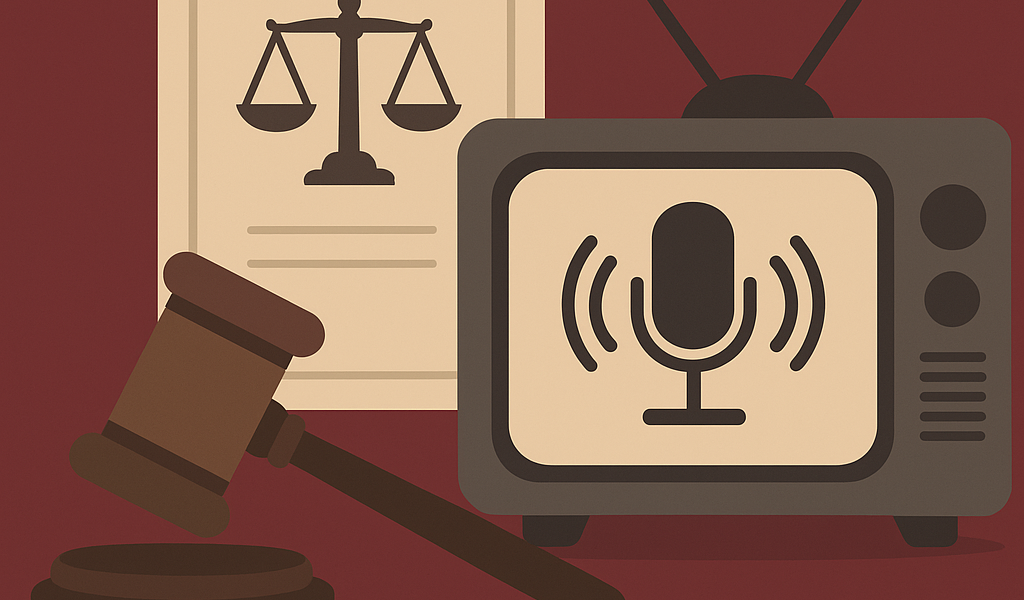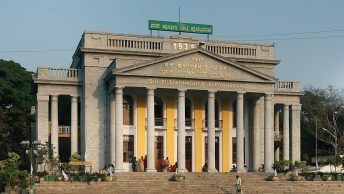Introduction
The recent fiasco of Samay Raina and “India’s got latent” has once again stirred conversations concerning online censorship. Article 19(1) recognises every citizen’s right to free speech and expression subject to reasonable restrictions as provided for under Article 19(2) of the Constitution. In Indian Express , the Apex Court confirmed that Article 19(1)(a) encompasses the freedom of the press, and that Courts must invalidate all laws and administrative actions which restrict the freedom of the press contrary to the constitutional mandate. The right to broadcast has also been ingrained in Article 19 as recognised in the MIB v. Cricket Association of Bengal case.
In 2023, in light of the growing digital and OTT sector, the Union Ministry of Information and Broadcasting [“MIB”] proposed the Broadcasting Services (Regulation) Bill, 2023 [“the bill”]. The bill sought to consolidate the legal framework for the entire broadcasting sector, improve accessibility for persons with disability and controversially, set up a three-tier content evaluation mechanism. Notably, the bill has an extremely wide scope, extending to news and current affairs programmes disseminated through online platforms, such as websites and social media intermediaries. While the Bill aims at modernising broadcasting law and improving accessibility, its provisions on content control mirror the chilling effects, executive overreach, and vague liability standards seen in frameworks that have been declared unconstitutional by Courts in the past.
Broadcasting Services (Regulation) Bill, 2023 – What is the proposed framework?
The bill has been introduced by the MIB to regulate broadcasting networks in India and form a uniform legal regime for the industry. The proposed act is divided in six chapters. The present piece shall focus on chapter III and chapter IV of the bill. First, Chapter III discusses certain rules and guidelines vis-à-vis the content standards. For instance, Section 19 of the bill states that programs and advertisements broadcasted through television, radio, or other broadcasting services are required to follow the prescribed guidelines. Similarly, Section 20 of the bill extends the application of the bill to news and current affairs programmes.
Second, Chapter IV of the bill further provides a three-tier regulatory structure to ensure compliance with chapter III. This regulatory structure comprises – self-regulation by broadcasters and broadcasting network operators, self-regulatory organisations and lastly, the Broadcasting Advisory Council. As per Section 27 of the bill, the Broadcasting Advisory Council is to be set up by the Central Government, and all members of the council shall be appointed by the Central Government itself. The council shall address the complaints concerning the violation of the programme code as may be referred to it by the Central Government or through appeals arising under Section 26 of the Bill. After deliberating upon the complaints, the Council will provide recommendations to the Central Government, and the Centre shall pass the final order.
The Constitutional Pitfalls
In this section, the author will contest the constitutional validity of the Bill on three counts. First, the bill will likely create a chilling effect amongst broadcasters, thereby encroaching upon their freedom of speech and expression under Article 19(1). Second, the provisions on censorship, as laid down in the bill, violate the rules of natural justice. Third, the excessive delegation of censorship powers to the executive is ultra vires of Article 19(1).
A Chilling Effect?
All laws and legislations that enable the pre-censorship of news or undermine the freedom of the press are ultra vires of Article 19(1)(a). However, this bill forms a blueprint for censorship as it allows censorship of news programmes that the Court deemed unconstitutional in Brij Bhushan.
Section 19 of the bill allows the Central Government to prescribe any guidelines it may deem fit for the advertisement and programme code. Compliance with such advertisement and programme codes is to be ensured by the Broadcasting Advisory Council. This three-tier regulatory scheme has been borrowed from the controversial IT Rules 2021. Rule 9 of the 2021 rules discusses the three-tier mechanism, with the topmost regulatory body being an oversight mechanism by the Central Government. Subsequently, the constitutionality of the rule was challenged before the Bombay HC. In Agij Promotion, the Court discussed the constitutionality of rule 9 and its alleged violation of Article 19. The Court noted that individuals would be hesitant to critique public figures, even if the publisher has valid grounds for doing so without engaging in defamation or any other legal provision resulting in the publisher violating rule 9 despite being within the constitutional restrictions of Article 19(2). Such hesitation amongst publishers will result in a chilling effect and consequently, the Court held that the regulatory mechanism under rule 9 had immense potential of creating a chilling effect amongst the publishers. A similar argument of chilling effect resulting in curtailment of the right to free speech was raised in the landmark judgement, Shreya Singhal where the Court struck down Section 66A of the IT Act. The Court noted that the provision was too wide in its ambit and curtailed an individual’s rights beyond the constitutional restrictions of Article 19(2) and, thus, declared it unconstitutional on grounds of overbreadth.
An analogical argument can be made in the present case with respect to the three-tier regulatory mechanism put forth by Section 24 of the Bill. Similar to the 2021 IT Rules , in the case of broadcasting bill, there can be internal biases of the self-regulatory committee, resulting in the curtailment of broadcasters’ rights under Article 19. Such inclusion of news publishers within the scope of the bill and the opening up of publishers to civil liability under Section 35 directly curtails press freedom and creates a chilling effect amongst the journalists. The broadcasting bill can lead to a severe chilling effect in its applicability to broadcasting by bringing about a manifestly unreasonable and arbitrary regime, thereby going against the constitutional safeguard of free speech and expression.
To add to the chilling effect, the broadcaster will be subject to civil liability for violating the advertisement and programme code prescribed by the central government. Therefore, naturally, the broadcasting network will eventually set up a conservative content evaluation committee and make the process of self-regulation more arbitrary as well.
Natural Justice and Bias
In another instance, the Bombay High Court faced with a similar issue while dealing with the Constitutionality of the 2023 amendment to the IT Rules 2021. The amendment brought in a fact-checking unit to be set up by the Central Government, and the unit would identify any “fake, false or misleading” information about the Centre’s business on social media platforms and subsequently take action against the social media intermediary for the same. The same was challenged before the Court in Kunal Kamra v. Union of India. Originally, there was a split verdict, with Justice Gokhale upholding its constitutionality and Justice Patel declaring it unconstitutional. However, it has been declared unconstitutional in the final judgement. The issue of the unit being set up by the Central Government was addressed on grounds of bias under Article 14 of the Constitution. Justice Patel noted that a unit deciding on the falsity of the information concerning the Centre being set up by the Central Government itself makes it arbitrary in the absence of any safeguard from bias. The rule makes the Central government a judge in its own case which goes against the principle of nemo judex in causa sua, a norm of natural justice whose violation results in arbitrariness thereby violating Article 14. Notably, the Court refused to limit the scope of bias and arbitrariness even in commercial cases.
With respect to the 2023 Broadcasting Bill, the bill calls for the setting up of a broadcasting advisory council, which shall hear the complaints and, thereafter, provide recommendations to the Central Government. The Central Government shall then pass any order after taking into consideration the recommendation of the broadcasting council. The Bill does not specify whether the Central Government is bound to follow the recommendations of the advisory council. Therefore, it leaves it to the discretion of the Central Government to decide on the final order. Such discretion with the Centre opens the playground for arbitrary and biased decisions since, practically, the Central Government will act as the judge in its own case. Furthermore, the appellate body deciding appeals from the recommendations of the advisory council shall be a body that is appointed by the advisory council itself, and its enforcement mechanism shall be the same as that of the council, thereby making the process of appeals technically redundant. The Court in Kunal Kamra considered such violations of the norms of natural justice sufficient to declare the law unconstitutional.
Excessive Delegation to the Executive
For commercial speech, although the constitutionality of censorship of such speech has been recognised by courts, this bill makes the Central Government act as the deciding authority, thereby raising concerns as to the bill’s constitutionality. Censorship, a means of enforcement of restrictions to free speech under Article 19(2) cannot be left to administrative discretion as it is unreasonable and arbitrary. The most notable example of a case of constitutional encroachment through administrative discretion is K.A. Abbas v. Union of India. The case, mostly known for upholding the constitutionality of pre-censorship of films, also dealt with the issue of administrative discretion. Under the Cinematograph Act, 1952, the final appellate powers from the decision of the board of censors was with the Central Government. This was deemed to be ultra vires. To circumvent this, the government brought in an amendment that set up a tribunal to discharge the function of censorship. However, the amendment allowed the Central Government to review the decisions of the appellate tribunal. The revisional power was struck down in K.M. Shankarappa, for being “a travesty of the Rule of law, which is one of the basic structures of the Constitution”. Allowing the Central Government to act as the censoring authority has been deemed to be ultra vires of Article 19(1)(a).
Despite judicial decisions recognising the unconstitutionality of censorship powers residing with the Central Government, Section 28 of the Bill vests the power in the Central Government to adjudicate and pass the requisite orders. Such administrative discretion in the adjudicating of matters concerning censorship creates a bias making its enforcement arbitrary and thereby violative of Article 14 of the Constitution.
Conclusion
While the Parliament’s efforts at modernising broadcasting laws and increasing accessibility is laudable, it must be within constitutional bounds. Its three-tier regulatory mechanism, with the threat of civil liability, creates a chilling effect amongst the broadcasters. The final authority being vested with the Central Government further raises concerns of arbitrariness in administrative action. In light of these concerns, it becomes essential to scrutinise the proposed bill’s constitutionality.
To ensure compliance with the constitutional framework, the author has the following recommendations. First, it is imperative to narrow the ambit of the bill to exclude news programmes from pre-censorship. Second, the legislature must codify transparent and objective content standards rather than provide the council with overly broad and vague discretion. At the same time, these standards must restrict themselves to the grounds mentioned in Article 19(2). Last, the bill must allow judicial review of the decisions made by the Council. Balancing the need for regulation with the preservation of fundamental rights is paramount, and any legislative framework must be in harmony with the constitutional principles that underpin India’s democracy.
Pritish Desai is a third-year student at the West Bengal National University of Juridical Sciences, Kolkata. His research interests include commercial law, constitutional law and public international law.
[Ed note: This piece was edited by Aditi Bhojnagarwala and published by Baibhav Mishra from the Student Editorial Team.]







I do not even know how I ended up here but I thought this post was great I dont know who you are but definitely youre going to a famous blogger if you arent already Cheers
Takipçi Satın Al
Takipçi Satın Al
I do believe all the ideas youve presented for your post They are really convincing and will certainly work Nonetheless the posts are too short for novices May just you please lengthen them a little from subsequent time Thanks for the post
I just wanted to drop by and say how much I appreciate your blog. Your writing style is both engaging and informative, making it a pleasure to read. Looking forward to your future posts!
İstanbul, Türkiye’nin ekonomik ve ticari merkezi olarak, hem bireylerin hem de şirketlerin vergi yükümlülüklerinin oldukça yoğun olduğu bir şehirdir. Vergi mevzuatındaki karmaşık düzenlemeler ve sık sık yapılan değişiklikler, mükelleflerin zaman zaman hukuki desteğe ihtiyaç duymasına yol açmaktadır. İstanbul vergi avukatları, hem gerçek hem tüzel kişilere, vergi uyuşmazlıklarında profesyonel danışmanlık ve temsil hizmeti sunarak, olası cezaların ve kayıpların önüne geçilmesine yardımcı olur.
Secesta, Türkiye’nin lider dijital çözüm sağlayıcısı olarak işletmelere özel SEO hizmetleri, yazılım geliştirme ve dijital pazarlama çözümleriyle fark yaratıyor. İstanbul merkezli bir ajans olan Secesta, arama motoru optimizasyonu (SEO) konusunda derin uzmanlığıyla markaların Google’da üst sıralarda yer almasını sağlıyor. Site içi SEO, teknik SEO, mobil uyumluluk ve hızlı yüklenen web siteleri geliştirme gibi konularda sektöre yön veren Secesta, aynı zamanda dönüşüm oranı yüksek reklam kampanyalarıyla ROI odaklı dijital pazarlama stratejileri sunuyor. Secesta’nın SEO hizmeti, sadece anahtar kelime odaklı değil; kullanıcı deneyimi, içerik kalitesi ve teknik altyapı gibi tüm yönleri kapsayan bütünsel bir yaklaşımı benimsiyor. ASP.NET Core, PHP ve WordPress teknolojilerinde uzman ekibiyle, performans odaklı web yazılımları geliştiren Secesta, her projeye özel SEO uyumlu kodlama ve içerik stratejileri sunarak uzun vadeli başarıya odaklanıyor. Google Ads ve Meta reklam yönetimi gibi dijital pazarlama alanlarında da %100 müşteri memnuniyetini hedefleyen Secesta, markaların dijital dünyadaki görünürlüğünü artırmak ve rekabet avantajı sağlamak için ideal bir iş ortağıdır. Eğer siz de dijitalde görünür olmak, SEO gücünüzü artırmak ve kalıcı başarılar elde etmek istiyorsanız, doğru yerdesiniz: Secesta ile dijitalde kazanın!